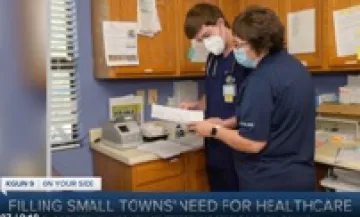UArizona adds new rural partner to Health Sciences program network
Medical trainees will have more opportunities to treat patients in counties federally recognized as having “healthcare professional shortages”

Arizona universities want to connect more doctors, nurses and healthcare professionals with families living in rural communities.
People who live in the state’s two biggest metro areas – Phoenix and Tucson – can generally find the specific medical care they need.
Contrast that with data from the Federal Health Resources and Services Administration. Information trackers have said more than 3.3 million Arizonans live in an area where there aren't enough medical professionals to meet people’s needs.

The University of Arizona’s Health Sciences program hopes current trainees seize the opportunity to build a career and a home in places like Gila, Graham and Greenlee counties.
UA Health Sciences keeps a map showing the counties where its Area Health Education Center (AHEC) programs treat patients.
Starting July 1, the program’s new partner, the Center for Excellence in Rural Education (CERE) will both serve people coming in for primary care and give medical students hands-on experience.
UA Health Sciences said CERE, based in Payson, will be one of six working AHEC locations.
In the 12 months spanning its fiscal year 2021-22, AzAHEC reports more than 1,500 future dentists, pharmacists and other trainees in UA Health Sciences programs spent time caring for people in the state's most medically underserved communities.
“Those folks, those graduates have become our best field faculty,” Dr. Daniel Derksen said. “(They’re) our best preceptors to help other students who are considering a career in a practice in a small town."
Derksen, a veteran family physician, still carries a similar experience in rural clinics, which he had early in his career.
Now, as AzAHEC’s principal investigator and senior adviser, Derksen said past programs that have taken this approach, with his guidance, have seen their investments pay off.
"About 80% of the graduates that go through residency and teaching health centers,” he said, "end up staying in primary care... more than half end up practicing in a federally designated health professional shortage area.

Derksen also said jobs often crop up when a primary care or specialist physician open a practice. He also observes, he said, tribal communities who have relationships with AzAHEC put more trust in the travel nurses and doctors who treat families in person.
Growing a program like this could inspire children in more rural communities to become the next healthcare leaders.
"We can't just train people in Phoenix and Tucson,” Derksen said. “What we have to do is balance that training with training in rural sites, so you're better prepared to go out. Hopefully, we're (also) training individuals from the community that really want to go back and practice there.”

Derksen said universities and partners should consider growing their investments – not only through tuition scholarships and loan repayments, but also the creation of a stronger tele-health infrastructure.

